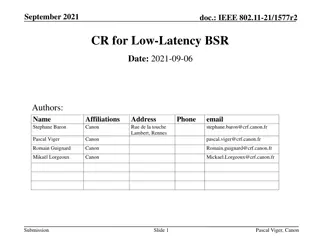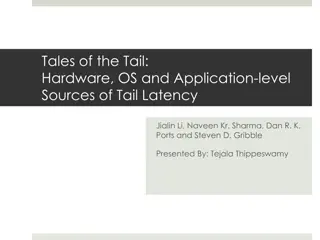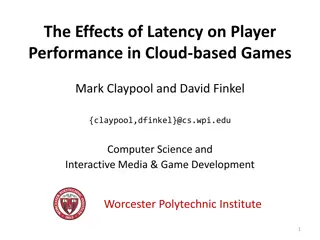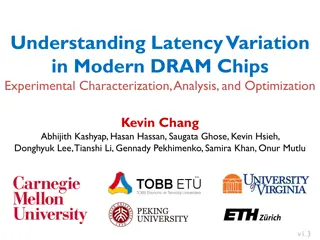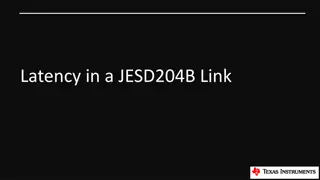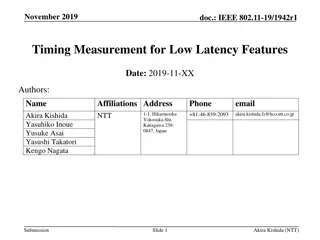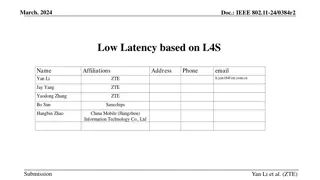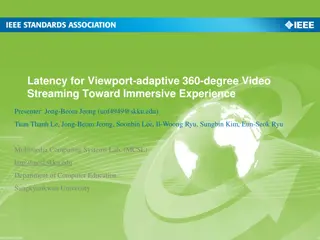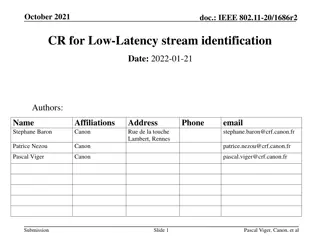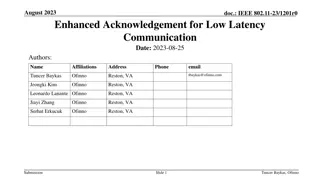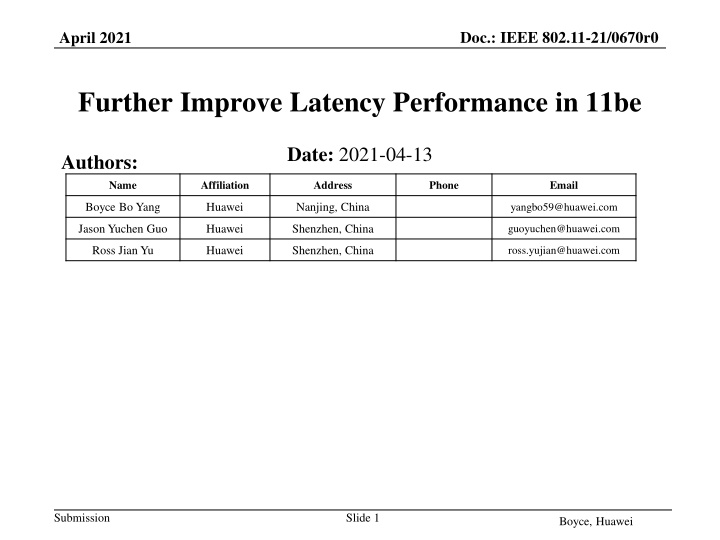
Optimizing Latency Performance in IEEE 802.11be Networks
Discover how the IEEE 802.11-21/0670r0 proposal aims to enhance latency performance in 11be networks by analyzing end-to-end delays in heterogeneous networks, addressing access delays through EDCA, and improving TXOP sharing for latency-sensitive traffic. Explore mechanisms to reduce latency tail in WLAN and prioritize latency-sensitive traffic for efficient transmission.
Download Presentation

Please find below an Image/Link to download the presentation.
The content on the website is provided AS IS for your information and personal use only. It may not be sold, licensed, or shared on other websites without obtaining consent from the author. If you encounter any issues during the download, it is possible that the publisher has removed the file from their server.
You are allowed to download the files provided on this website for personal or commercial use, subject to the condition that they are used lawfully. All files are the property of their respective owners.
The content on the website is provided AS IS for your information and personal use only. It may not be sold, licensed, or shared on other websites without obtaining consent from the author.
E N D
Presentation Transcript
Doc.: IEEE 802.11-21/0670r0 April 2021 Further Improve Latency Performance in 11be Date: 2021-04-13 Authors: Name Affiliation Address Phone Email Boyce Bo Yang Huawei Nanjing, China yangbo59@huawei.com Jason Yuchen Guo Huawei Shenzhen, China guoyuchen@huawei.com Ross Jian Yu Huawei Shenzhen, China ross.yujian@huawei.com Submission Slide 1 Boyce, Huawei
Doc.: IEEE 802.11-21/0670r0 April 2021 E2E Delays in heterogeneous networks Wired Networks (Ethernet and IP) Source WLAN - 1 WLAN - 2 Destination A typical data path nowadays consists of three hops, wireless LAN, wired network, and then wireless LAN. E2E delay is a combination of transmission delays of wireless and wired networks. For wired networks, many efforts have been made over last several years, such as TSN, DetNet etc. For wireless LANs, 802.11be also aims at providing better delay performance for latency sensitive traffic. This proposal is to provide some mechanism to further improve latency performance in 11be Submission Slide 2 Boyce, Huawei
Doc.: IEEE 802.11-21/0670r0 April 2021 Analysis on access delays when using EDCA Latency-sensitive traffic arrives Backoff: 10 Backoff: 20 DIFS+ 27us DIFS+ 27us DIFS+ 36us 5 ms 5 ms STA a STA b STA c STA d The figure above shows where the latency tail comes from in WLAN. Waiting for the transmission of other ongoing PPDUs of the device itself. Backoff and frequently being interrupted by transmissions of other STAs Collisions and backoff with a larger window Submission Slide 3 Boyce, Huawei
Doc.: IEEE 802.11-21/0670r0 April 2021 Improved TXOP Sharing (1) Latency-sensitive traffic usually has higher priority than non-latency- sensitive traffic. While it is still possible that the backoff counter of latency sensitive traffic is larger at some time. The backoff counter of non-latency-sensitive traffic may start to count down earlier The backoff counter of non-latency-sensitive traffic happens to choose a small value Latency sensitive traffic has to wait until the device has obtained the second or even the third TXOP. Pre-EHT STAs are not allowed to include MPDUs from other ACs in the TXOP if the TIDs from primary AC are not empty. (Note: The AC that gains an TXOP is referred to as the primary AC.) TXOP 1 TXOP 2 PHY HDR 1 Latency-sensitive AC 2 1 3 2 1 LS MPDU 4 3 2 1 Non-Latency-sensitive AC PHY HDR Non-LS MPDUs 1 2 1 Submission Slide 4 Boyce, Huawei
Doc.: IEEE 802.11-21/0670r0 April 2021 Improved TXOP Sharing (2) A minor amendment can improve the delay performance of latency sensitive traffic: Latency sensitive traffic belonging to any AC that has a higher priority with respect to the primary AC is allowed to be included in the A-MPDU or multiple frame transmission within the TXOP. TXOP 1 Latency-sensitive AC 4321 321 PHY HDR LS Non-LS MPDUs Non-Latency-sensitive AC MPDU 21 1 Latency-sensitive traffic in an A-MPDU as a secondary AC TXOP 1 4321 Latency-sensitive AC 321 PHY HDR LS MPDU PHY HDR Non-Latency-sensitive AC Non-LS MPDU 21 1 Latency-sensitive traffic in multiple frame transmission in other AC s TXOP Submission Slide 5 Boyce, Huawei
Doc.: IEEE 802.11-21/0670r0 April 2021 Pre-emptible PPDU aggregation The device may have a TXOP and is transmitting non-latency-sensitive traffic when latency-sensitive traffic arrives. In that case, latency sensitive traffic has to wait until the TXOP ends and contends the channel again. LS traffic arrives HDR LS payload HDR Non-LS payload TXOP 1 TXOP 2 Delay To reduce delay of latency-sensitive traffic, we can introduce a pre-emptible PPDU so that latency sensitive traffic can be sent in current TXOP The transmitter can end the ongoing PPDU after the nearest segment with a PPDU end marker, and then send latency-sensitive traffic within the TXOP. The PPDU end marker could be a rotation of L-LTF or some other predefined sequences. Submission Slide 6 Boyce, Huawei
Doc.: IEEE 802.11-21/0670r0 April 2021 Pre-emptible PPDU aggregation- Example 1 For a long non-latency-sensitive PPDU as long as 4ms, the transmitter can choose to interrupt the transmission and reassign the TXOP to latency sensitive traffic To this end, PHY layer needs to encode a 4ms PPDU payload into 4 PPDU payloads, each of which is 1ms, when latency sensitive traffic does not arrive. HDR Payload Payload Payload Payload When latency sensitive traffic arrives during the transmission of non-latency-sensitive traffic, PHY layer can end at the nearest boundary with a PPDU end marker. The receiver would deliver the segments that have been received to upper layer. SIFS SIFS HDR PPDU Payload PPDU Payload PPDU Payload PPDU Payload HDR LS payload HDR PPDU end marker Submission Slide 7 Boyce, Huawei
Doc.: IEEE 802.11-21/0670r0 April 2021 Pre-emptible PPDU aggregation- Example 2 The transmitter can also choose to finish the ongoing transmission and send the latency sensitive traffic subsequently When there is no latency sensitive traffic arrives, PHY layer encodes a PPDU as usual and wait for ACK HDR Payload HDR BA When latency sensitive traffic arrives during the transmission of non-latency-sensitive traffic, PHY layer can insert a PPDU sequence end marker at the end of the PPDU. So the following frame exchange is interrupted and the transmitter can send latency sensitive traffic instead. The receiver would not send a BA and expect to receive a latency sensitive PPDU after SIFS when a PPDU sequence end marker is detected at the end of a PPDU. SIFS HDR PPDU Payload HDR LS payload HDR M-TID BA PPDU sequence end marker Submission Slide 8 Boyce, Huawei
Doc.: IEEE 802.11-21/0670r0 April 2021 Pre-emptible PPDU aggregation- Example 3 The transmitter can also choose to interrupt the ongoing transmission directly When there is no latency sensitive traffic arrives, PHY layer encodes a PPDU as usual and wait for ACK HDR Payload HDR BA When latency sensitive traffic arrives, PHY layer can interrupt the ongoing transmission with a PPDU end marker and send latency sensitive traffic after SIFS. The receiver may discard part or all of the received bits depending on whether a complete MPDU has been received. SIFS HDR Payload HDR LS payload PPDU end marker Submission Slide 9 Boyce, Huawei
Doc.: IEEE 802.11-21/0670r0 April 2021 Transmitter block diagram of PHY Transmitter block diagrams for Pre-EHT PPDU Data field Transmitter block diagram for L-SIG, RL-SIG,U-SIG, HE-SIG-A fields Transmitter block diagram for EHT PPDU Data field Data bits of EHT PPDU 2 Data bits of EHT PPDU 1 Pre-FEC Padding, Scrambler, LDPC Encoder, Post FEC Padding, Stream Parser, Constellation mapper, LDPC Tone mapper, CSD, Spatial and Frequency mapping, IDFT, Insert GI, window Analog and RF Control Switch bits of PHY Header PPDU End Marker Control signal Generating PPDUs shown in previous examples Generate 1 PHY Header and then 4 Data fields HDR Payload Payload Payload Payload Switch to generate PPDU End Marker at the end of the first PPDU Data field HDR Payload Payload HDR LS payload HDR Switch to generate PPDU End Marker at any time HDR Payload HDR LS payload Submission Slide 10 Boyce, Huawei
Doc.: IEEE 802.11-21/0670r0 April 2021 Conclusion We give some basic ideas on further improving latency and jitter performances in 11be. Submission Slide 11 Boyce, Huawei
Doc.: IEEE 802.11-21/0670r0 April 2021 Reference [1] 11-20-1670-02-00be-low-latency-resource-agreements [2] 11-20-1897-03-00be-obss-edca-parameter-sets-for-rta Submission Slide 12 Boyce, Huawei
Doc.: IEEE 802.11-21/0670r0 April 2021 BACKUP Current rules for TXOP sharing in md5.0 Frames from ACs other than the primary AC shall not be included in the TXOP, with the following exceptions (TXOP sharing): Additional rules for TXOP sharing in ax8.0 If the TXOP limit of the primary AC is greater than 0, then the STA may aggregate QoS Data frames from one or more TIDs in the AMPDU under the following conditions: Submission Slide 13 Boyce, Huawei

